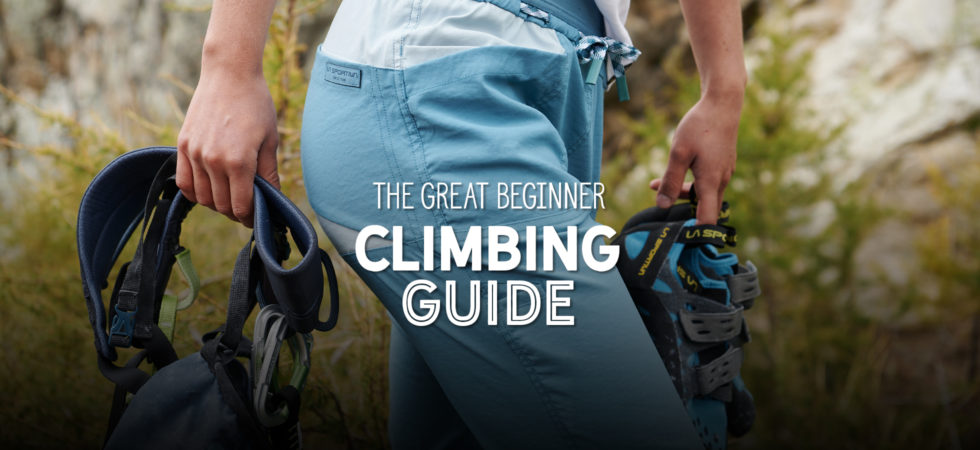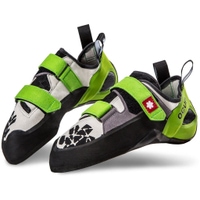Summer with its countless outdoor possibilities is just around the corner – biking, hiking, trail running and, of course, climbing should not be missed. This year is your first time going climbing and you do not know what you need and what is important? No worries, we will quickly tell you everything in this guide! We briefly explain which climbing equipment is essential, what you should know about it and what else you should consider.
Climbing Shoes – Tight, but comfortable
As with almost all other sports, the right footwear is also crucial when you are climbing. Unlike hiking or running shoes, where there should be some space in front, climbing shoes must fit like a second skin – tight and at the same time not uncomfortable. That way you have a better feeling in your toes and can move more safely. In general, climbing shoes are very light and have a smooth rubber sole with which you have a particularly good grip.
For more details and information take a look at our buyer’s guide on climbing shoes.
Harness – The connection between you and the rope
As well as shoes, the harness belongs to the essential equipment for climbing. It is basically the connection between the climber and the rope. Without a harness, secured climbing would not be possible.
As with the shoes, it is important for the harness that it fits well but does not cause pain. Even if you take a break during your climbing tour and sit in the belt for some time, it should still be comfortable. At the same time, the belt should not be too big. The important thing is that the strap fits around your stomach – not around your hips! The leg loops have the right size when your flat hand still fits between the loop and the leg. With adjustable leg loops, you’re on the safe side, also when wearing thicker pants.
Rope – Your most essential support
As soon as you are a bit more experienced and would like to do some more lead climbing, you should also consider getting your own climbing rope. The standard, both indoors and outdoors, is the so-called dynamic single rope. Single rope means that it is used in the single strand as opposed to the twin or half rope. Dynamically indicates the slight stretchability of the rope.
To choose the right length, you should first consider for which purpose you need the rope. For indoor climbing, you do not need a particularly long rope – 40m should be enough. However, 40m would be too short for rock climbing outdoors. There you need a length of around 60 to 70m. Concerning the diameter of the rope, 9.8 to 10.2mm is usually ideal. Thicker ropes are more robust, but also heavier. Thinner ropes are lighter but have to be replaced faster.
Belaying Device – In the event of a fall
As you do not want to get yourself or your climbing partner hurt, the right belaying is crucial. No worries, there is a large selection of different belaying devices out there, such as the Grigri from Petzl. If you use these devices properly, belaying your partner is no big deal. Nevertheless, you should not take it lightly, after all you have a big responsibility!
Climbing Helmet – Protection against falls and falling rocks
A helmet is just as essential for climbing as a rope or a harness – safety on the mountain comes always first! A helmet not only protects you from falling stones, but also from crashing with your head against the rock. In addition to good protection, you climbing helmet should be light and have a comfortable fit.
Two types of climbing helmets can be distinguished – the so-called inmoulding helmet and the hybrid helmet. Hybrid helmets have a sturdy hard shell with a styrofoam insert for cushioning. With inmoulding helmets, however, the styrofoam is injected directly into the shell, which consists of thin polycarbonate. This makes the inmoulding helmet much lighter, but also less resistant. Thus, it needs to be replaced more often than the hybrid helmet. In terms of protection, both helmets are very good.
Chalk and chalk bag – For more grip on the rock
Putting some chalk, or actually magnesium carbonate, on your hands when climbing, keeps them dry even if you are sweating. This gives you a better grip when climbing outdoors as well indoors and protects you from slipping. Little chalk bags, which you can easily attach to your harness, make it possible to carry the chalk with you when climbing.
Quickdraws – The protection for in between
Quickdraws are two carabiners which are connected by a band loop. One carabiner is hung on your rope, the other one on hooks in the wall or in the rock. These hooks serve as a temporary protection – in an emergency, you cannot fall lower than you last intermediate fixing point.
Climbing halls usually have permanently installed quickdraws that stay permanently on the wall. But as soon as you want to get out in nature and on the rock, you have to bring your own quickdraws. Depending on how long the routes are, you will need a set of 8 to 12 quickdraws for the beginning.
Climbing partner – Safer and more fun as a team
An essential part of the climbing equipment is, of course, the right climbing partner! Climbing is clearly a team sport. Solo climbing and self-belaying are possible, but you need sufficient experience and additional equipment. For beginners, it is definitely not recommended – besides, it makes way more fun together!
Coordination and a head for heights
When climbing not only good equipment is important, but also a good coordination, physical strength, agility and of course a head for heights. Being anxious when climbing can quickly lead to blockades and cause injuries. However, having a head for heights can be trained as well as coordination and other physical conditions. In order not to get into dangerous situations, it is always important to keep an eye on your own limits and to assess your abilities correctly.
Mental Strength – Stay positive
Climbing is clearly a matter of mind. In addition to the necessary physical strength and agility, mental strength is particularly important – it helps you to get better and to try out more difficult routes. Positive thinking is essential! It is also crucial to reflect on your own strengths and weaknesses – only then you can consciously use them or consciously counter them. Do not compare yourself with others, especially as a beginner this can be quite demotivating.
A commonly used mental technique in climbing is visualization – before climbing go through the route in your head and think in advance how to best master it.
Good weather – Unsafe without it
Of course, the weather also plays an important role in outdoor climbing. Make sure to have a look at the weather forecast before you go – you should definitely avoid being out on the mountain during bad weather. If the weather is unstable you should rather play it safe and pay a visit to the climbing hall.
You want to learn how to climb and secure like a professional?
In our blog post Climbing camps and trainings in the Alps you will find an overview of workshops and courses that will help you get started with climbing or take your skills to the next level. Maybe you will find the perfect climbing partner there, who knows?
More useful blog posts:
→ The most popular types of climbing
→ Effective training for climbers with BLACKROLL®
→ Safe on the mountain and in the climbing hall: Everything about ropes
Foto Header: RedChilli/©Moritz Attenberger












